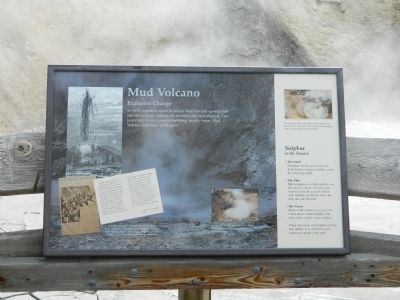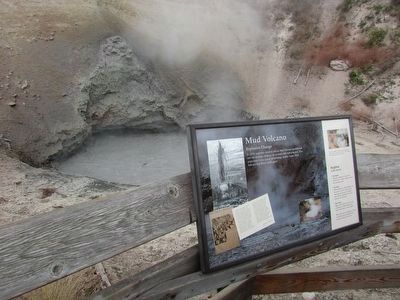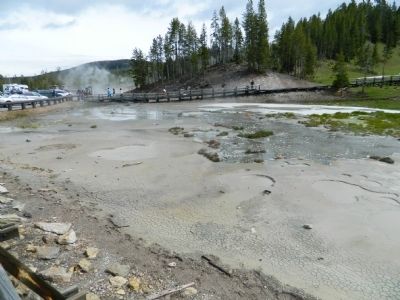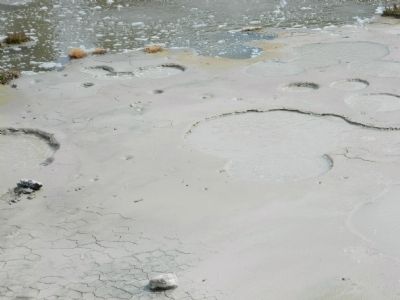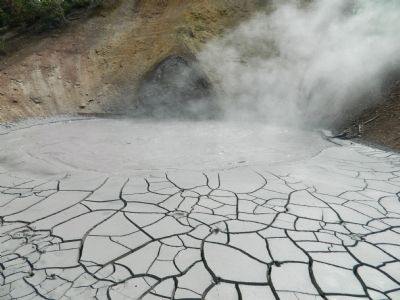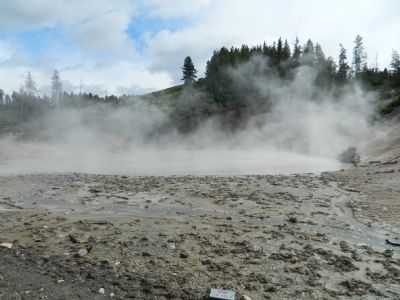Mud Volcano
Explosive Change
In 1870, explorers stood in awe as Mud Volcano spewed mud into the treetops, shaking the ground with each eruption. Two years later it was a pool of bubbling, muddy water. Mud Volcano has blown itself apart!
While returning by a new route to our camp, dull, thundering sounds, which General Washburn likened to frequent discharges of a distant mortar, broke upon our ears. We followed their direction, and found them to proceed from a mud volcano, which occupied the slope of a small hill, embowered in a grove of pines. Dense volumes of steam shop into the air with each report, through a crater thirty feet in diameter. The reports, though irregular occurred as ofter as every five seconds, and could be distinctly heard half a mile. Each alternate report shook the ground a distance of two hundred yards or more, and the massive jets of vapor which accompanied them burst forth like the smoke of burning gunpowder.
Nathaniel P. Langford
1870
Sulphur is the Source
The Smell
Hydrogen sulfide gas rising from Yellowstone's magma chamber causes the rotten-egg smell
The Mud
Microorganisms, or thermophiles, use this gas as a source of energy, and then help turn the gas into sulfuric acid. Sulfuric acid breaks down the rock and soil into mud.
The Colors
Many of the colors you see are
When iron mixes with sulphur to form iron sulfide, gray and black swirls sometimes appear in the mud.
Photo Caption
For many decades, visitors have been intrigued by Mud Volcano's powerful odor and the yellow sulphur that is most common in late summer.
Topics. This historical marker is listed in this topic list: Natural Features. A significant historical year for this entry is 1870.
Location. 44° 37.489′ N, 110° 26.043′ W. Marker is in Yellowstone National Park, Wyoming, in Park County. It is in Mammoth. Marker is on Grand Loop Road. Touch for map. Marker is in this post office area: Yellowstone National Park WY 82190, United States of America. Touch for directions.
Other nearby markers. At least 8 other markers are within walking distance of this marker. Dragon's Mouth Spring (here, next to this marker); Cooking Hillside (about 500 feet away, measured in a direct line); Grizzly Fumarole (about 700 feet away); Mud Geyser (approx. 0.2 miles away); Volcanic Landscape (approx. ¼ mile away); Sulphur Caldron (approx. ¼ mile away); Churning Caldron (approx. ¼ mile away); Black Dragon’s Caldron (approx. 0.3 miles away). Touch for a list and map of all markers in Yellowstone National Park.
Credits. This page was last revised on February 16, 2023. It was originally submitted on August 20, 2011, by Bill Pfingsten of Bel Air, Maryland. This page has been viewed 602 times since then and 13 times this year. Photos: 1. submitted on August 20, 2011, by Bill Pfingsten of Bel Air, Maryland. 2. submitted on September 3, 2015, by Bill Coughlin of Woodland Park, New Jersey. 3, 4, 5, 6. submitted on August 20, 2011, by Bill Pfingsten of Bel Air, Maryland.
